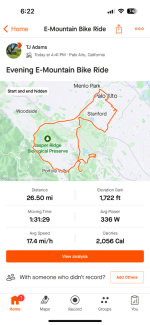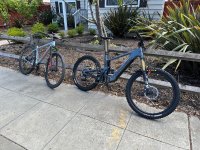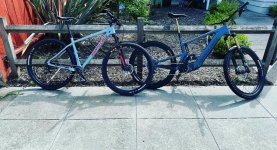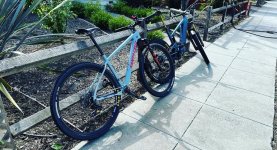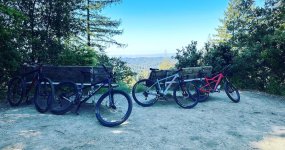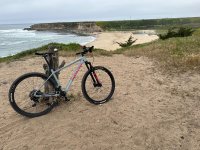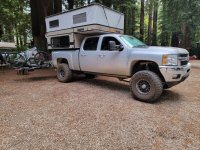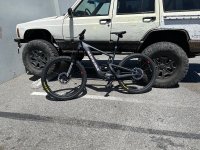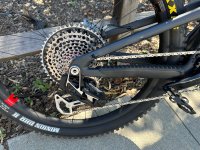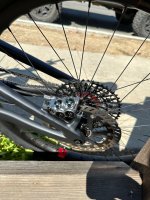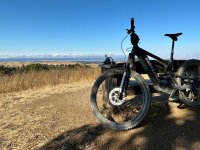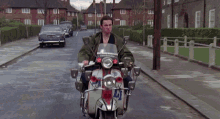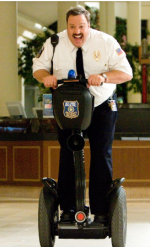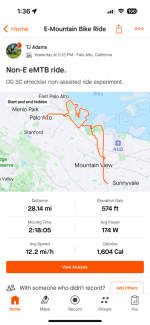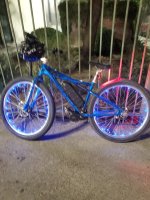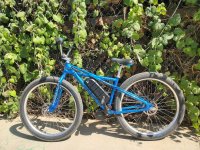Where to start, where to start...
I guess I'll start by addressing all the e-bike haters. There are different types, or "classes" of e-bikes.
The
California vehicle code defines e-bikes as: “[A] bicycle equipped with fully operable pedals and an electric motor of less than 750 watts.” It further breaks e-bikes into three categories, following a classification system created by PeopleForBikes that has been adopted in 40 states.
- Class 1: Provides assistance only when the rider is pedaling and ceases to provide assistance when the bicycle reaches a speed of 20 mph
- Class 2: Operates via pedal-assist or throttle and ceases to provide assistance when the bicycle reaches a speed of 20 mph
- Class 3: Provides assistance only when the rider is pedaling and ceases to provide assistance when the bicycle reaches a speed of 28 mph
Most "stock" eMTBs are Class 1. Some hybrids, roadies and "commuter" e-bikes are Class 3. IIRC no OE "bicycle manufacturers" offer Class 2s, but IDK maybe there are some commuter type bikes with throttle, to be honest I've never shopped that market.
So what does all of that mean, and why does it matter?
Well getting back to the "haters", Class 1 and Class 3 e-bikes (the only things I really consider e-bikes, as opposed to pedal-assisted EVs) don't help unless you're putting effort in.
The assist you get is relative to the effort you put in: the harder you work, the more the bike will help (with a scale that's based on the setting you're in).
All (or nearly all) have various levels/settings of assist, including no assist. There is no throttle, period. You have to work for the bike to put in assist. You have to work harder to get more assist. And you can turn it off.
I have two Santa Cruz Heckler eMTBs (one is a top-trim '23 in XL that's for sale, BTW... the other a top-trip '24 in L that I found fits me better) and they are both Class 1. They actually begin to tapper assist out at ~17 MPH and feel like they're "done" helping more like 18-19 MPH than 20 MPH to me. These bikes weigh ~50lbs, have giant tires with terrible rolling resistance, a ton of plush susp travel, and are generally inefficient machines. I also have a '16 or '17 Santa Cruz Highball NON-e hardtail I have setup with some very fast tires (for "mountain bike" tires) and I'd say carrying 16-17 MPH on flat ground in the Highball is as easy, or easier than carrying 16-17 MPH on the same terrain on one of the eHecklers in the "Eco" (lowest assist mode, after off of course) mode. Even in mild climbing it's about a wash, but on very steep climbs even in Eco the eHeckers are probably a bit easier... maybe.
Last week I put ~62miles in across 2 rides exclusively on the eMTBs. IIRC I did something like 5k feet of climbing in that mileage, I'll post the rides in a bit from another device. I use Strava for ride tracking, and I have my age/height/weight and the bikes entered. I also select "E-Mountain Bike Ride" when I record eMTB rides, so in theory Strava is working off of the knowledge it's an eMTB that is assisting. Of course without a proper power meter setup (with the crankset containing the strain gauge so it's measuring the efforts *I* put in, before the assist) and without capturing heart rate it's a pretty wild guess. Even if we assume they're 50% optimistic, at a "reported" 3k and 2k calories for the rides respectively, or ~5k total... a real world 2500 calories of burn is still pretty good.
And no matter how you slice it, it's ~4hrs I spent outside breathing fresh air with an elevated heart rate, not at my keyboard (or on the couch) which can't be a bad thing.
Sure, had I done the identical rides on a non-E bike in the same time/speed it would have been "better for me." But I'm flat-out not capable of the two rides I did at this pace on a non-E bike. I'd say generally I'm working as hard as I would on the eMTBs as I would be working on a non-E, I'm just going way further/faster and doing more climbing in the same time. But if that's the case, why bother with the E? Why not just do shorter (distance) rides in the same time? Do less climbing etc.? Well, that's a great question, and there's no single answer. I still have my Highball to do just that, I just haven't gotten out on it recently (truth be told, after a winter of slacking off and excuses like holidays/weather/travel I've only been back on the bike in the last 2-3 weeks).
I suppose the BEST thing to do would be to go out for the same amount of time on the non-E and push myself as hard as possible. But that's not always possible in the real world. A hill is a hill, or a stiff headwind is a stiff headwind, etc. no matter how you're feeling. It's easier to hit your mental limit and give up or turn back if you don't have a crutch to fall back on (yes, I recognize the assist is a crutch, in a way). With the E-bike you don't have that apprehension about attacking the next climb, or "taking the loop one more time", or riding on a day you don't feel 100%, etc.
And let's not forget you can turn the assist down, or off. I do a ride often on Tuesdays with a buddy that works semi-local to me. After work I ride ~9 miles to meet up with him, I use assist for this to make it as fast as possible. Generally on that ride when I look at the data I'm hovering in the 18 MPH range (it's a mostly flat, non-technical ride to our meet up spot). Basically I'm pushing as hard as I can hovering between where the bike is helping, and where it's not. No, I couldn't maintain 18 MPH w/o the assist on that bike, but I'm also not just sitting back twisting a throttle (remember, there is NO throttle on a Class 1 or 3). Then when we meet up I turn assist completely off. He rides a kind of hybrid/commuter non-E bike (well, rode... he just bought an eMTB) and overall he's slower than me. Where we ride is basically all compacted granite or gravel bike paths, so his bike is faster/more efficient. But I'm faster than him, so having my tank turned off levels the playing field and we can ride together without me feeling like I'm not getting any workout in. We usually do about 15 miles that way, then split off at the same point (meaning I have ~9mi still to ride back). For the ride back I put the assist back on, and depending on how much I'm racing the sunset, I might even set it up all the way to "boost" and try to really jam. All in I'm riding ~33mi with a bit under half being no assist. Again, would it be better if I did the exact same thing on my non-E Highball? Sure. Is it likely I would do it? No, not at all.
Also, there's the aspect of leveling the playing field. I'm around 6', and right now about 210lbs (like I said... I let things go a bit over the winter :drinkup: ) but I have riding buddies that are half a foot shorter than me and at least 50-60lbs lighter and a decade younger. They also ride 5-7 days a week (literally). There's just no world where I'll ever be able to hang with them naturally. So before the eMTBs going riding with them was kind of a drag, for everyone. I felt super self-conscious about it, like I was holding everyone up and ruining their ride/workout (because, let's be honest, I was) and I'm sure they were annoyed having to wait on me. It basically led to avoiding that group/those rides. Since these guys aren't douches, they don't care that I show up on an eMTB now, because we can all hit the ride and be pushing ourselves to our own personal limits, but ride together.
The bottom line is since I bought my first eMTB the amount of time I spent riding went way, way up. My fitness level definitely improved, and I see/feel the results in my legs and otherwise. Whether some (or all of it) is just the mental thing that knowing I'm going out on the eMTB gets me out the door when I might otherwise have stayed in, I don't know. But it DOES GET ME OUT THE DOOR. And that's worth the $.
Back on topic
@matt86m, as for what e-bike to buy, well that's a complicated topic too. If you intend to mostly use it on trails as you stated, I'd say a "traditional" full suspension eMTB. I say "traditional" to mean, not some goofy ass fat-tire thing, not some pseudo-motorcycle looking thing, but a thing that looks like a good ole mountain bike and behaves like one too. My Santa Cruz Hecklers are basically electrified Santa Cruz Bronsons. You get lots of plush suspension, big tire (NOT fat tire) grip/comfort, and the E makes up for the giant weight and efficiency hits (though the SC full suspension bikes are very efficient *for full susp* with the VPP tech) vs. a hardtail like my Highball. You also don't look like a total dingus on a fake motorcycle thing (sorry Glamis Mike

) or some hipster fixed frame/fork fat tire BS. However, I will say I can't really recommend anything to you at the sub-$2k price point. You get what you pay for (to an extent) and $2k just don't go far enough to have a quality full susp frame, quality fork/rear shock, quality components, quality e-drivetrain, quality wheelset etc. And when I say quality I don't mean "top notch" or "over the top." I mean reliable and functional. Any sub-$2k full susp eMTB is going to have issues and let you down in some way. E-bikes are particularly sensitive to quality rear derailleurs (well, front or rear, but I'd only by a 1x setup on just about any bike these days), which get expensive. And the tech can get wild...
Speaking of tech... the drivetrain on my newer Heckler actually uses timing marks on the rear cogs to phase/time gear changes.
"Combined with X-Sync teeth, the cassette has specific shift lanes that permit or block the chain from moving to the next gear. Specific shift ramps, according to SRAM, mean the chain is always in permanent contact with the cassette as it shifts." This is the magic and means no clunky-thunky shifting even when under power with assist on. "Shift ramps and X-Sync teeth are combined with firmware-based derailleur Cassette Mapping. The timing created by the cassette’s X-Sync tooth pattern means the derailleur’s shift sequence aligns with the shift ramps; it only shifts to the next gear when it is permitted to do so by the cassette and when the firmware knows a ramp is ‘available’."
In effect, it acts a bit like how a DCT is still engaging the "previous" gear as it starts to engage the "next" gear. When you shift it keeps the chain engaged with the previous cog as it begins engagement with the next, so there's no dead-time and there's no big "hit" and clunk between gears even shifting while putting in full power (I've always let up on power input while keeping the cranks moving as I've shifted on bikes to avoid this, but it's super hard to do on a E-bike as it's tough to get all the timing just right with the electric assist). I can tell a huge difference in how my '24 with this tech shifts vs. my '23. Also, the '24 has 4-piston calipers and semi-floating rotors, lol.
-TJ

